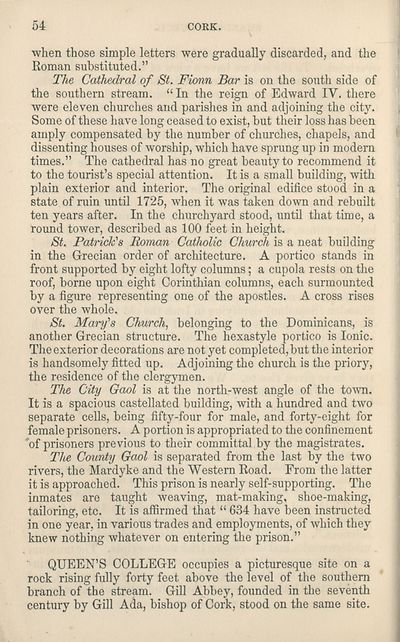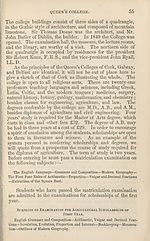Download files
Complete book:
Individual page:
Thumbnail gallery: Grid view | List view

54
CORK.
when those simple letters were gradually discarded, and the '
Roman substituted.”
The Cathedral of St. Fionn Bar is on the south side of
the southern stream. “ In the reign of Edward IV. there
were eleven churches and parishes in and adjoining the city. ;
Some of these have long ceased to exist, but their loss has been ;
amply compensated by the number of churches, chapels, and I1
dissenting houses of worship, which have sprung up in modern !
times.” The cathedral has no great beauty to recommend it i
to the tourist’s special attention. It is a small building, with
plain exterior and interior. The original edifice stood in a
state of ruin until 1725, when it was taken down and rebuilt
ten years after. In the churchyard stood, until that time, a
round tower, described as 100 feet in height.
St. Patrick's Borman Catholic Church is a neat building
in the Grecian order of architecture. A portico stands in
front supported by eight lofty columns; a cupola rests on the
roof, borne upon eight Corinthian columns, each surmounted
by a figure representing one of the apostles. A cross rises j
over the whole.
St. Mary's Church, belonging to the Dominicans, is j
another Grecian structure. The hexastyle portico is Ionic. I
The exterior decorations are not yet completed, but the interior j
is handsomely fitted up. Adjoining the church is the priory, |
the residence of the clergymen.
The City Gaol is at the north-west angle of the town. j
It is a spacious castellated building, with a hundred and two j
separate cells, being fifty-four for male, and forty-eight for
female prisoners. A portion is appropriated to the confinement
'of prisoners previous to their committal by the magistrates.
The County Gaol is separated from the last by the two
rivers, the Mardyke and the Western Road. From the latter ,
it is approached. This prison is nearly self-supporting. The
inmates are taught weaving, mat-making, shoe-making,
tailoring, etc. It is affirmed that “ 634 have been instructed
in one year, in various trades and employments, of which they
knew nothing whatever on entering the prison.”
QUEEN’S COLLEGE occupies a picturesque site on a
rock rising fully forty feet above the level of the southern
branch of the stream. Gill Abbey, founded in the seventh
century by Gill Ada, bishop of Cork, stood on the same site.
CORK.
when those simple letters were gradually discarded, and the '
Roman substituted.”
The Cathedral of St. Fionn Bar is on the south side of
the southern stream. “ In the reign of Edward IV. there
were eleven churches and parishes in and adjoining the city. ;
Some of these have long ceased to exist, but their loss has been ;
amply compensated by the number of churches, chapels, and I1
dissenting houses of worship, which have sprung up in modern !
times.” The cathedral has no great beauty to recommend it i
to the tourist’s special attention. It is a small building, with
plain exterior and interior. The original edifice stood in a
state of ruin until 1725, when it was taken down and rebuilt
ten years after. In the churchyard stood, until that time, a
round tower, described as 100 feet in height.
St. Patrick's Borman Catholic Church is a neat building
in the Grecian order of architecture. A portico stands in
front supported by eight lofty columns; a cupola rests on the
roof, borne upon eight Corinthian columns, each surmounted
by a figure representing one of the apostles. A cross rises j
over the whole.
St. Mary's Church, belonging to the Dominicans, is j
another Grecian structure. The hexastyle portico is Ionic. I
The exterior decorations are not yet completed, but the interior j
is handsomely fitted up. Adjoining the church is the priory, |
the residence of the clergymen.
The City Gaol is at the north-west angle of the town. j
It is a spacious castellated building, with a hundred and two j
separate cells, being fifty-four for male, and forty-eight for
female prisoners. A portion is appropriated to the confinement
'of prisoners previous to their committal by the magistrates.
The County Gaol is separated from the last by the two
rivers, the Mardyke and the Western Road. From the latter ,
it is approached. This prison is nearly self-supporting. The
inmates are taught weaving, mat-making, shoe-making,
tailoring, etc. It is affirmed that “ 634 have been instructed
in one year, in various trades and employments, of which they
knew nothing whatever on entering the prison.”
QUEEN’S COLLEGE occupies a picturesque site on a
rock rising fully forty feet above the level of the southern
branch of the stream. Gill Abbey, founded in the seventh
century by Gill Ada, bishop of Cork, stood on the same site.
Set display mode to:
![]() Universal Viewer |
Universal Viewer | ![]() Mirador |
Large image | Transcription
Mirador |
Large image | Transcription
| Antiquarian books of Scotland > Ireland/Irish > Black's guide to Killarney and the south of Ireland > (66) |
|---|
| Permanent URL | https://digital.nls.uk/118861460 |
|---|
| Description | Thousands of printed books from the Antiquarian Books of Scotland collection which dates from 1641 to the 1980s. The collection consists of 14,800 books which were published in Scotland or have a Scottish connection, e.g. through the author, printer or owner. Subjects covered include sport, education, diseases, adventure, occupations, Jacobites, politics and religion. Among the 29 languages represented are English, Gaelic, Italian, French, Russian and Swedish. |
|---|

